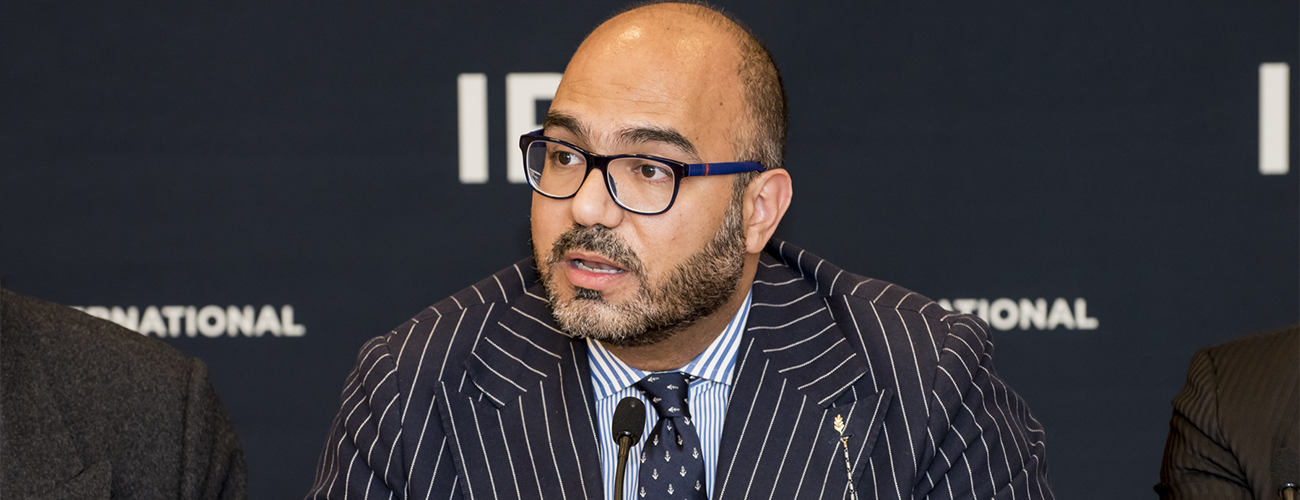The fight for gender equality is a fight that should not be fought by women, but by men for women and with women,” Mohammad Naciri said at a March 16th IPI policy forum on the theme of men’s roles in preventing violence against women.
“Men hold many of the positions of power across the globe, and we must work with them on building a more constructive masculinity,” said Mr. Naciri, who is Regional Director for the Arab States at UN Women. Mr. Naciri went on to tell the forum, which was co-sponsored by the Permanent Mission of Estonia, that if a more concerted effort is not made by those in power, “A 50-50 planet is not going to happen by 2030.” His reference was to the fifth Sustainable Development Goal, which aims for gender equality and empowerment of all women and girls.
Highlighting the efforts that are being made by UN Women to reduce the harmful effects of traditional masculinity, Mr. Naciri mentioned an initiative made by his organization to promote reading of religious texts through an “ungendered eye.” Identifying religion as a key source of patriarchal attitudes, Mr. Naciri emphasized the importance of approaching texts such as the Koran from this perspective.
Introducing the event, IPI Senior Adviser Warren Hoge said that “analyzing the roles, attitudes and behaviors of men and boys from a gender perspective can also deepen understanding of conflict and insecurity.” Each contributor to the panel built upon this primary argument.
In opening remarks, Sven Jurgenson, Permanent Representative of Estonia to the UN, also addressed the problem of prevalent patriarchal attitudes, pointing out that 42% of Estonians believe that a woman can be to blame for her own sexual assault because of what she was wearing.
Mr. Jurgenson also spoke of organizations such as the White Ribbon Campaign, which seeks to banish such attitudes by enlisting powerful men to pledge never to commit, condone or stay silent about violence towards women. Participants wear a white ribbon pin on their lapel to publicly show their support, and Ambassador Jurgenson called attention to his own pin while speaking.
Christian Veske, Stakeholder Relations Officer at the European Institute for Gender Equality, offered a presentation with slides on the White Ribbon movement. Mr. Veske told the panel that there are currently 40 high-profile political figures working with the movement as ambassadors, though he admitted younger men tend to be more interested in ambassadors from outside the political sphere, such as actors and athletes.
Mr. Naciri similarly acknowledged the differences in the roles that can be played by younger men and older men, noting that “to change policies and legislations, we’re working with older men, and to work on communication for behavioral change, we’re working with youth and younger men.”
Pirkko Mattila, Finland’s Minister of Social Affairs and Health, agreed that the participation of men and boys is instrumental in preventing female genital mutilation, sexual violence, trafficking and domestic violence.
As for how best to achieve this participation, Ms. Mattila said that “attitudes and behavior can be changed through education, awareness-raising and training. In the prevention of violence, men have key roles as role models and spokespersons.”
Doreen Sioka, Minister of Gender Equality and Child Welfare in Namibia, was represented by Wilhencia Uiras, who described the legislative protections that Namibia has built into its constitution. Ms. Uiras, who is Namibia’s Permanent Secretary in the Ministry of Gender Equality and Child Welfare, also pointed to the success of a training manual that had been developed “to equip facilitators with skills and knowledge to work with men and boys.”
Ms. Uiras continued by noting that since the introduction of these measures, “Men have engaged in the national dialogue, discussing issues relating to gender-based violence, and solutions to these problems.”
“It is critical for men to get involved,” Ms. Uiras said. “Not just as legislators, not just in terms of judiciary, but as roles models. In the house, raising songs, and being exemplary. Once we have that, we will start seeing a difference in how men relate to women.”








